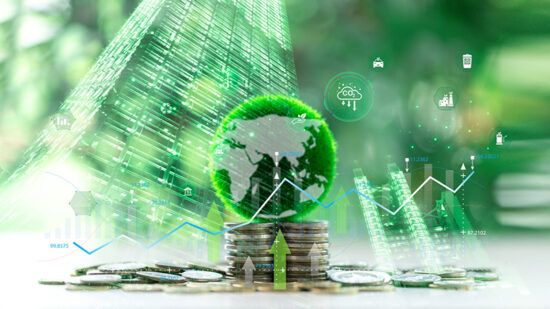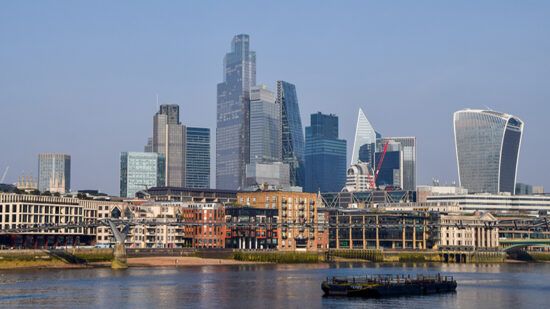In this Green Dream video interview, Morningstar Sustainalytics head of sustainable investing research Hortense Bioy discusses the rollercoaster past few years in sustainable investment, how regulation will bring some much-needed clarity and what investors need to know about performance.
She also shares why more sustainable investments in different asset classes need to be opened up and why the SDR label up-take will be much lower than initially expected.
Watch the full video interview above and read the transcript below.
NK: Hello, I’m Natalie Kenway, and welcome back to the Green Dream video interview. I’m here in the Morningstar Sustainalytics office with Hortense Bioy, who is head of sustainable investing research. Thank you so much for your time. I’m sure the future readers are familiar with you, as you’ve been on the Committee for a while – since launch really. So thank you very much for your support. I want to ask you about roller coaster we’ve seen over the past few years for sustainable investing, and that’s noted in the quarterly flow reports that Morningstar produces. What has been one of the most interesting developments over that time for you? What stood out?
HB: So first of all, thank you for having me. One thing that really stood out for me the last few years is the, the extent and the speed at which, the sustainable investing space has grown over the past few years. I’ve been in this space for now seven years, and I’ve seen the acceleration of that momentum, we’ve seen ESG now becoming really mainstream. What I mean by that ESG integration, so the consideration of ESG factors in investment processes, but we’ve also seen a proliferation of products, ESG and sustainable strategies, the growth of assets as well. So this really has stood out for me in the last few years.
Of course, as you mentioned, on a quarterly basis we produce flow reports. So we’ve seen a decline in inflows into ESG and sustainable funds globally. And some places there are outflows, but in Europe there’s inflows. I think it’s important to say that there are still inflows in this space. And, these flows have declined against a very challenging macro environment since the war in Ukraine, which has pushed energy prices up, inflation up, interest rates have gone higher.
This hasn’t really been a favourable environment for certain companies involved in renewable energy, for example, but also in other sectors. As we know, there’s been some underperformance also, due to the fact that, in general, ESG funds tended to be underweight in traditional energy and overweight in technology that has really, penalised ESG funds in 2022.
There were more mixed performance last year. But I think, on the back of the underperformance in 2022, a lot of investors have taken a more cautious approach to ESG products. And that also has happened in a in a broader context of greenwashing, accusations of politicisation of ESG, especially in the US.
So all those factors, can explain partly the decline in inflows into those products. But we’re seeing so far this year inflows going up again. Not to the extent that we’re seeing in the rest of the market.
NK: Yeah. It feels like there’s a bit more of a sensible approach now and then, everyone just piling in, jumping on the bandwagon like it felt a few years ago. And, picking up on the greenwashing you mentioned. We’ve seen lots of regulatory measures being brought in to try and counteract the greenwashing. Do you think that’s enough? And do you think the investors are confident again around the greenwashing concerns?
HB: Some of these measures are being implemented. I think it’s probably too early to tell if there are going to have a positive impact or alleviate all of investors’ concerns regarding greenwashing.
But hopefully that will. It’s important to understand that one of the objective of this anti greenwashing measures in the UK, but also in the EU, is really to increase transparency and help investors better understand the strategies that they’re investing in, and also to push asset managers to be more specific and more explicit and more transparent about the environmental and social outcomes that investors should expect from investing in those products.
This is exactly what SDR is about; increasing transparency, making sure that asset managers don’t make unsubstantiated claims. Now the regulator stopped short of defining green and defining what a sustainable investment should look like. So it’s really still up to the asset managers to define their own standards.
Some would say there’s then some room for potentially some risk, around some greenwashing risk. But I think that really depends on your definition of greenwashing. In the EU, of course, there’s also SFDR, a focus on more transparency. Depending on your claims, you have to disclose more or less information, that’s Article 8 or 9. More recently, ESMA also has introduced some minimum safeguards, depending on the terms that ESG funds use in their names. So that could, lead to some exclusions of fossil fuel exclusions, for example, which is something well – some investors really want it. But there’s still gaps in the EU regulation, for example, around the definition of sustainable investment. That is still a cause of concern for some investors because the current definition under SFDR still leaves some room for interpretation, and that leads to incomparable results. Ss you know, SFDR is under review. We have yet to see what comes out of that
But I want to finish, by saying also that the EU has something that the UK doesn’t have yet – that’s a taxonomy.
NK: Yes, a UK green taxonomy is supposed to have been on the cards for a few years now.
HB: That’s right. So the EU has a taxonomy and as of today there are very few funds that can claim alignment with that taxonomy.
But in the future we can expect more green funds that are aligned with the taxonomy of funds that will be green. because it’s also important to talk about the transition, and that’s what I think will alleviates these concern.
NK: Let’s talk about the UK again. We had the final proposals for SDR announced last year. They were really, really warmly welcomed. the industry was really behind the fund labels, we have had the anti greenwashing come out in May. And now asset managers can choose to adopt those from labels from the end of July. From our conversations. they are reluctant to share what they’re doing or they said they don’t know what they’re doing yet in terms of choosing which label. And it’s I think it’s now perceived to be a bit trickier than initially thought is. Is that the sort of vibes you’re getting from the industry? What do you what’s your conversations been like?
HB: Absolutely. We published a study back in January, so that was was six months ago, and we predicted that around 300 funds could use a label or would want to use a label because they have certain terms in their name that indicate they’re offerings have those ESG, characteristics or sustainability characteristics.
But, we said at the time that there was an optimistic number and, yes, there won’t be there won’t be 300 funds labelled by the end of the year. it’s hard to predict really what the number is going to be. We’ve heard that asset managers didn’t have enough time to do impact assessments or adjust the strategies, or even adjust the disclosure. Some might say the criteria for the labels are too strict, and also others have said we don’t think there is a first mover advantage, so we’re going to wait and see what the demand from investors will look like.
So yes, I think it’s fair to say that we shouldn’t expect many funds to be labelled by the end of this year, and even fewer at the end of July, which is the first time to use labels.
It will take time for this market of labelled funds to shape up, there will also be a universe of unlabelled funds that potentially will be bigger than this universe of labelled funds. So you’re going to have there some disclosure which will meet investors demand for more transparency, so that’s good. But we also may also end up actually with a bigger universe than the universe of labelled funds.
NK: Yes, 300 isn’t a great number in the grand scheme of how many funds there are out there, so it will be interesting to see how it pans out and what it looks by the end of the year or perhaps next year.
We’ve talked a lot about regulation, but thinking about your general outlook for the sustainable investment industry, what would you say the challenges and opportunities are for the next five years or so?
HB: Regulation will have the benefit of bringing clarity and that strong foundation for the sustainable investing industry. So that’s good. But I think there will still be challenges, for the industry in the coming years. I’m going to mention two challenges, and I’m sure there are others and even more that are not yet clearly defined, but one is around performance. So much has been written and debated about the performance of sustainable investments, whether you have to sacrifice returns if you want to invest sustainably.
Some studies said that, yes certainly, absolutely stop dreaming, you can’t have your cake and eat it. Other studies show that no, you can actually invest sustainably and not sacrifice returns. So the jury is still out. I think it’s going to be something that the industry will have to address, and explain to investors when there are periods of underperformance like we’ve seen the past couple of years, why that is and why also investors shouldn’t expect, a particular strategy to outperform all the time, or thrive in any market environment – that doesn’t exist.
Also it’s a good reminder for investors, that they should be investing for the long term. And also looking at short-term performance may not be the best thing to do.
That’s one challenge for the industry performance, the second challenge is impact, investors want to invest sustainably because they want to make a difference.
They think, these products can have an impact, right? I mean, of course, it depends on the strategies. But the challenge for asset managers will be to demonstrate that impact.
NK: It’s a tricky one.
HB: It is a tricky one. Now, the good news one opportunity for the industry is that in surveys after surveys, we hear that there is a high and growing appetite for sustainable investments. So the demand is there, and that’s a good thing.
Now, another opportunity for the industry – and I’m going to say something that now really sounds very cliché -investors have a very important role to play in the transition to a low carbon economy. There are lots of opportunities arising from climate change. I think we’ve only scratched the surface there.
And, the challenge, but also the opportunity for investors, for the industry will be to make more opportunities for investors accessible. I’m thinking about private markets, I’m thinking about emerging markets. I’m thinking about less traditional asset classes that will need to be made more accessible to investors.
NK: Just picking up on your performance point before we wrap up, is there that an argument as well that if there are companies that aren’t thinking about things from a sustainable perspective, then they will get left behind though or they won’t be around anymore because they need to think about this. This is something that’s happening all the time.
HB: I mean companies transform they grow but some disappear. That’s part of the life of a company. There are a lot of challenges that are related to environmental and social issues. And today the reality is they have to disclose how these issues impact them and also the impact that their activities have on the environment and society at large.
It’s not like something that they can’t think about it. It’s not a luxury or just even a regulatory exercise. They should embrace these new disclosure requirements. And I’m thinking about CSRD in particular in Europe, but which will impact more companies. outside of Europe. It’s about how to take that as an opportunity to rethink the strategy, to better identify the risks, and build more sustainable businesses over time.
NK: And another reason to not focus on short-term performance right?
HB Absolutely!
NK: Well, thank you very much. We always finish with this question. What is your favourite sustainable drink or snack?
HB: That’s a great question. So I’m addicted to chocolate, but I don’t know if it’s that sustainable.
NK: There are some sustainable brands out there…
HB: Yeah but I eat a brownie a day. I don’t know if that’s sustainable either… But it has to be dark chocolate, but that’s the snack I would be pick because I don’t drink coffee, I don’t drink. So it would be dark chocolate or a brownie.
NK: Great choice. Thank you very much for your time and thank you for having us in your office.
HB: Thank you for having me.








